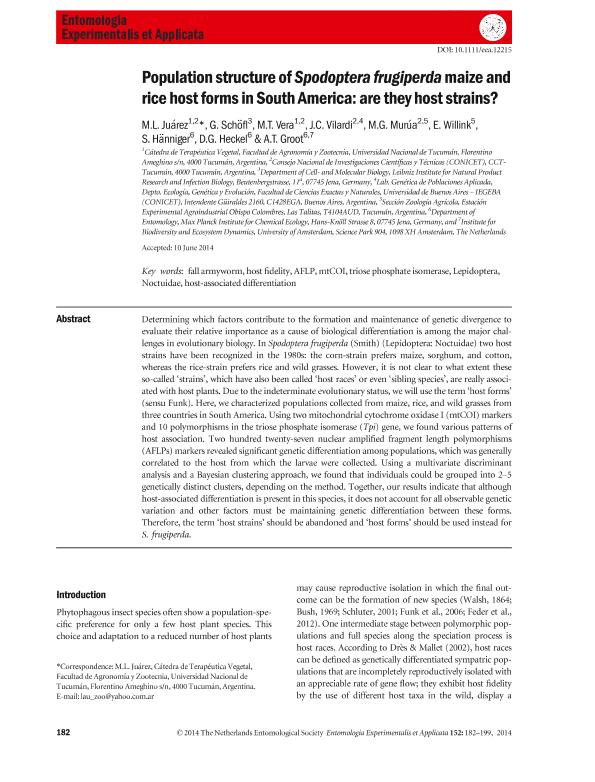Mostrar el registro sencillo del ítem
dc.contributor.author
Juárez, María Laura

dc.contributor.author
Schöfl, G.
dc.contributor.author
Vera, Maria Teresa

dc.contributor.author
Vilardi, Juan Cesar

dc.contributor.author
Murúa, María Gabriela

dc.contributor.author
Willink, E.
dc.contributor.author
Hänniger, S.
dc.contributor.author
Heckel, D. G.
dc.contributor.author
Groot, A. T.
dc.date.available
2017-02-01T21:19:40Z
dc.date.issued
2014-09
dc.identifier.citation
Juárez, María Laura; Schöfl, G.; Vera, Maria Teresa; Vilardi, Juan Cesar; Murúa, María Gabriela; et al.; Population structure of Spodoptera frugiperdamaize and rice host forms in South America: are they host strains?; Wiley; Entomologia Experimentalis Et Applicata; 152; 3; 9-2014; 182-199
dc.identifier.issn
0013-8703
dc.identifier.uri
http://hdl.handle.net/11336/12336
dc.description.abstract
Determining which factors contribute to the formation and maintenance of genetic divergence to evaluate their relative importance as a cause of biological differentiation is among the major challenges in evolutionary biology. In Spodoptera frugiperda (Smith) (Lepidoptera: Noctuidae) two host strains have been recognized in the 1980s: the corn-strain prefers maize, sorghum, and cotton, whereas the rice-strain prefers rice and wild grasses. However, it is not clear to what extent these so-called ‘strains’, which have also been called ‘host races’ or even ‘sibling species’, are really associated with host plants. Due to the indeterminate evolutionary status, we will use the term ‘host forms’ (sensu Funk). Here, we characterized populations collected from maize, rice, and wild grasses from three countries in South America. Using two mitochondrial cytochrome oxidase I (mtCOI) markers and 10 polymorphisms in the triose phosphate isomerase (Tpi) gene, we found various patterns of host association. Two hundred twenty-seven nuclear amplified fragment length polymorphisms (AFLPs) markers revealed significant genetic differentiation among populations, which was generally correlated to the host from which the larvae were collected. Using a multivariate discriminant analysis and a Bayesian clustering approach, we found that individuals could be grouped into 2–5 genetically distinct clusters, depending on the method. Together, our results indicate that although host-associated differentiation is present in this species, it does not account for all observable genetic variation and other factors must be maintaining genetic differentiation between these forms. Therefore, the term ‘host strains’ should be abandoned and ‘host forms’ should be used instead for S. frugiperda.
dc.format
application/pdf
dc.language.iso
eng
dc.publisher
Wiley

dc.rights
info:eu-repo/semantics/openAccess
dc.rights.uri
https://creativecommons.org/licenses/by-nc-sa/2.5/ar/
dc.subject
Fall Armyworm
dc.subject
Triose Phosphate Isomerase
dc.subject
Aflp
dc.subject
Host Fidelity
dc.subject
Population Structure
dc.subject.classification
Zoología, Ornitología, Entomología, Etología

dc.subject.classification
Ciencias Biológicas

dc.subject.classification
CIENCIAS NATURALES Y EXACTAS

dc.title
Population structure of Spodoptera frugiperdamaize and rice host forms in South America: are they host strains?
dc.type
info:eu-repo/semantics/article
dc.type
info:ar-repo/semantics/artículo
dc.type
info:eu-repo/semantics/publishedVersion
dc.date.updated
2017-01-31T18:29:29Z
dc.identifier.eissn
1570-7458
dc.journal.volume
152
dc.journal.number
3
dc.journal.pagination
182-199
dc.journal.pais
Estados Unidos

dc.journal.ciudad
Hoboken
dc.description.fil
Fil: Juárez, María Laura. Universidad Nacional de Tucumán. Facultad de Agronomía y Zootecnia. Cátedra. Terapéutica Vegetal; Argentina. Consejo Nacional de Investigaciones Científicas y Técnicas; Argentina
dc.description.fil
Fil: Schöfl, G.. Leibniz Institute for Natural Product Research and Infection Biology; Alemania
dc.description.fil
Fil: Vera, Maria Teresa. Universidad Nacional de Tucumán. Facultad de Agronomía y Zootecnia. Cátedra. Terapéutica Vegetal; Argentina. Consejo Nacional de Investigaciones Científicas y Técnicas; Argentina
dc.description.fil
Fil: Vilardi, Juan Cesar. Consejo Nacional de Investigaciones Científicas y Técnicas. Oficina de Coordinación Administrativa Ciudad Universitaria. Instituto de Ecología, Genética y Evolución de Buenos Aires; Argentina
dc.description.fil
Fil: Murúa, María Gabriela. Gobierno de Tucumán. Ministerio de Desarrollo Productivo. Estación Experimental Agroindustrial Obispo Colombres; Argentina. Consejo Nacional de Investigaciones Científicas y Técnicas; Argentina
dc.description.fil
Fil: Willink, E.. Gobierno de Tucumán. Ministerio de Desarrollo Productivo. Estación Experimental Agroindustrial Obispo Colombres; Argentina
dc.description.fil
Fil: Hänniger, S.. Instituto Max Planck Institut Fur Chemische Okologie; Alemania
dc.description.fil
Fil: Heckel, D. G.. Instituto Max Planck Institut Fur Chemische Okologie; Alemania
dc.description.fil
Fil: Groot, A. T.. Instituto Max Planck Institut Fur Chemische Okologie; Alemania. University Of Amsterdam; Países Bajos
dc.journal.title
Entomologia Experimentalis Et Applicata

dc.relation.alternativeid
info:eu-repo/semantics/altIdentifier/doi/http://dx.doi.org/10.1111/eea.12215
dc.relation.alternativeid
info:eu-repo/semantics/altIdentifier/url/http://onlinelibrary.wiley.com/doi/10.1111/eea.12215/abstract
Archivos asociados
